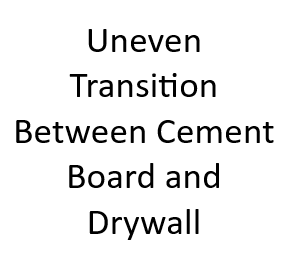When it comes to home improvement projects, the devil is often in the details. One such detail that can prove to be a challenging hurdle is managing the uneven transition between cement board and drywall. Whether you’re renovating your bathroom, kitchen, or any area with high moisture exposure, this transition can be a source of frustration. In this blog post, we’ll explore the causes of uneven transitions, common issues that arise, and practical solutions to achieve a smooth, professional finish.
Understanding the Challenge
Before we delve into solutions, it’s crucial to understand why uneven transitions occur in the first place. The primary reason is the difference in thickness and composition between cement board and drywall.
Cement board, often used in wet areas like bathrooms and kitchens, is thicker and denser than standard drywall. This difference in thickness can result in an uneven surface when they meet. Additionally, the two materials expand and contract at different rates due to variations in humidity and temperature, which can exacerbate the problem.
Common Issues with Uneven Transitions
- Visible Seam: The most obvious problem is a visible seam between the cement board and drywall. This seam can be unsightly and can undermine the overall aesthetics of your project.
- Cracking and Gaps: Uneven transitions can lead to cracks and gaps over time. These not only look unattractive but also provide an entry point for moisture, which can lead to further damage.
- Difficulty in Finishing: Achieving a smooth finish over an uneven transition can be challenging. It may require multiple layers of joint compound and sanding, extending the project timeline.
Solutions for a Seamless Transition
Now that we’ve identified the issues, let’s explore some effective solutions to create a seamless transition between cement board and drywall.
- Use the Right Materials:
- Start by selecting the correct cement board thickness. Typically, ½-inch cement board is used to match the thickness of ½-inch drywall.
- Ensure that you have the appropriate joint tape and joint compound for the job. Fiberglass mesh tape is recommended for cement board and drywall transitions.
- Tapered Edges:
- Use tapered-edged drywall for a smoother transition. These edges are thinner and create a more gradual transition from the drywall to the cement board.
- Apply Joint Compound:
- Apply a layer of joint compound over the seam between the cement board and drywall. Feather the edges to create a gradual slope.
- Allow the compound to dry and sand it down to achieve a smooth, even finish. This may require multiple coats and sanding sessions.
- Waterproofing:
- In areas prone to moisture, such as bathrooms, ensure proper waterproofing measures. Apply a waterproofing membrane over the cement board before tiling or finishing.
- Corner Bead:
- Consider using a corner bead designed for uneven transitions. These specialized beads are designed to create a smooth transition and minimize cracking.
- Professional Help:
- If you’re unsure about tackling this project yourself, don’t hesitate to seek professional help. Experienced contractors can ensure a flawless transition.
Advanced techniques and tips for managing the uneven transition between cement board and drywall.
Backer Rod and Caulk:
-
- For exterior applications or areas with extreme temperature fluctuations, consider using backer rod and caulk. This method is especially useful for sealing gaps and preventing moisture infiltration.
- Insert a backer rod into the gap between the cement board and drywall. Then, apply a high-quality silicone or polyurethane caulk over the backer rod. This creates a flexible, waterproof seal that accommodates the differential movement between the materials.
Transition Trim Profiles:
-
- Transition trim profiles, often made of materials like PVC or metal, are designed to provide a clean, finished look to uneven transitions. These profiles come in various shapes and sizes, allowing you to select the one that best suits your project’s aesthetics.
- Installing transition trim profiles not only conceals the seam but also protects it from damage and wear over time.
Texture Matching:
Achieving a seamless transition also involves matching the texture of the surrounding drywall. This step is often overlooked but can significantly enhance the overall appearance of the transition.
Use texture spray or a texture roller to replicate the texture of the surrounding drywall. Practice on a spare piece of drywall first to ensure a perfect match.
Regular Maintenance:
Even with the best techniques and materials, it’s essential to perform regular maintenance to ensure the transition remains in excellent condition. Check for any signs of cracking, peeling, or gaps, and address them promptly.
Plan Ahead:
Proper planning is key to avoiding uneven transitions. When framing walls or planning your layout, consider the thickness of both materials and make necessary adjustments to minimize uneven transitions.
Educate Yourself:
If you’re a DIY enthusiast, take the time to educate yourself about cement board and drywall installation. Numerous online tutorials and resources can provide valuable insights and guidance for your project.
In conclusion, managing the uneven transition between cement board and drywall is a task that requires attention to detail and the use of appropriate techniques and materials. Whether you’re tackling a home renovation or a new construction project, achieving a seamless transition not only enhances the appearance of your space but also contributes to its long-term durability.
Remember that while DIY is a great option for many, there are instances where it’s best to seek professional help, especially if the transition is in a critical area like a shower or a kitchen backsplash.
By following these advanced techniques and tips, you’ll be well-equipped to overcome the challenges posed by uneven transitions, ensuring a professional and polished finish for your home improvement project.
